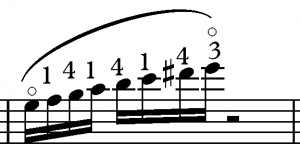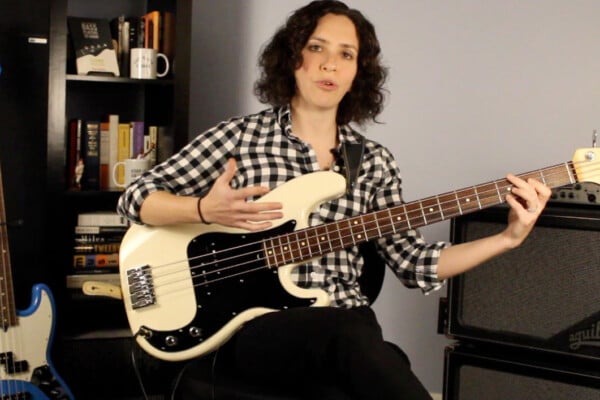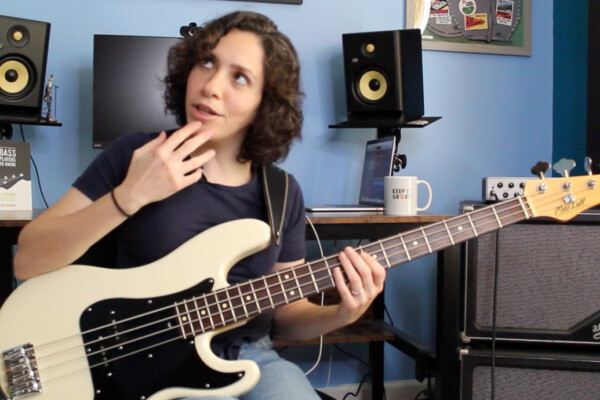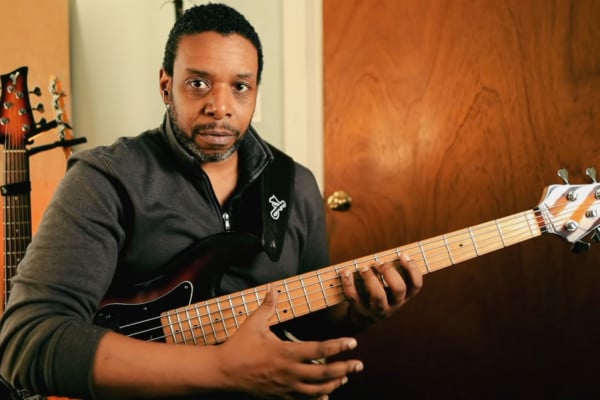Grouping Multiple Notes Into a Single Action/Thought
When playing at slow speeds we can concentrate on our physical movements for every single note we play. However, this becomes impractical at high rates of speed.
When playing at high speed it helps to group notes, and motions, together into a single action. The number of notes we can combine will depend on the requirements of the specific passage, but in general: the faster the passage, the larger the group of notes.
We already apply this concept of “grouping” when we speak. We don’t think of pronouncing every single syllable, rather we group them together as phrases and sentences. We can apply this same concept to musical performance.
Let’s take this passage as an example:

* We’ve used a traditional fingering here, but this concept works with any fingering system.
Some might be tempted to think of the physical motions required for the above passage in this way:
- Play the first three notes in one position
- Shift and play the next two notes in the new position
- Shift and play the next two notes in the new position
- Shift and play the final note in the new position
As many steps as the above breakdown is, we are already combining actions if we think this way: We are grouping each shift and the notes in the subsequent position into one thought/motion. However, we can reduce these steps further.
To make the entire passage one single group/thought/motion I suggest the following procedure:
Begin by playing the first three notes.
- Repeat this many times; with one beat rest in between each repetition. Depending on the ultimate tempo desired you may, or may not, be able to play it at speed. If it is too fast for you, you can play it slower, but don’t go too slowly. We don’t want to go below a moderate speed.
- Do this until the action of each finger doesn’t seem individual, but rather all three notes, and their required motions, merge into one action both mentally and physically.
Add the next two notes, incorporating the shift and the next two notes, i.e. up to the D.
- Repeat these five notes; with one beat rest in between each repetition.
- Do this until the shift and all the actions of the fingers merge into one fluid thought and motion.
- No jerkiness of thought or motion for the shift. Keep it smooth.
Add the next two notes, incorporating the next shift and the next two notes, i.e. up to the F#.
- Repeat these seven notes; with one beat rest in between each repetition.
- Do this until the shift and all the actions of the fingers merge into one fluid thought and motion.
- No jerkiness of thought or motion for the shifts. Keep it smooth.
Add the final note, incorporating the final shift, i.e. up to the G.
- Do this until the shift and all the actions of the fingers merge into one fluid thought and motion.
- No jerkiness of thought or motion for the shifts. Keep it smooth.
Instead of many individual actions, the passage should now feel as if only one single thought/action is required to play all the notes.
- If it doesn’t, repeat the above steps in order, taking extra time on each step.
- Don’t add notes until everything previous feels like one thought/motion.
Once you have the entire passage as one motion, repeat it many times for consistency and solidification. Always place one beat rest in between repetitions.
Now go and apply this concept to the speedy passage of your choice.
Dr. Donovan Stokes is on the faculty of Shenandoah University-Conservatory. Visit him online at www.donovanstokes.com and check out the Bass Coalition at www.basscoalition.com.




You may have just changed my life. Thank you!
Maybe I’m not understanding something, this is a G major scale right? From the 10th fret on the D I can do this at 150bpm without having to move my hand at all, so what’s this all about, am I not comprehending the lesson?
This method is most likeley for double bass. It could apply to electric as well if you are playing a G major scale up the G string, but on upright this is how you would play a one octave G major scale
Hi Jeff,
The concept here is not the fingering, but the motion. So the concept applies to electric bass as well, whatever the fingering. The fingering is not important, just used here as a tool, and because it includes shifting. Also, the fingering above is just one of many available on the upright bass.
Hi Robert, This fingering is irrelevant, it would apply to your fingering mentioned above (I believe you meant 10th fret on the A string.) It’s really about grouping many notes in to one motion and one mental thought. So long as you are thinking about moving every individual finger, your speed will be limited.
It’s something we already do when we reach for a doorknob, for example. We don’t think about first lifting our forearm from our side and then extending our arm, then opening our hand, then grabbing the doorknob, etc. etc., then make every move individually. All the moves have been “grouped” in our mind and body.
Hope this helps.
D
Oh yes I did mean the A string and thanks for the reply. That makes sense, at fast tempos many riffs become all one motion for me so I guess that’s the whole point of the lesson.